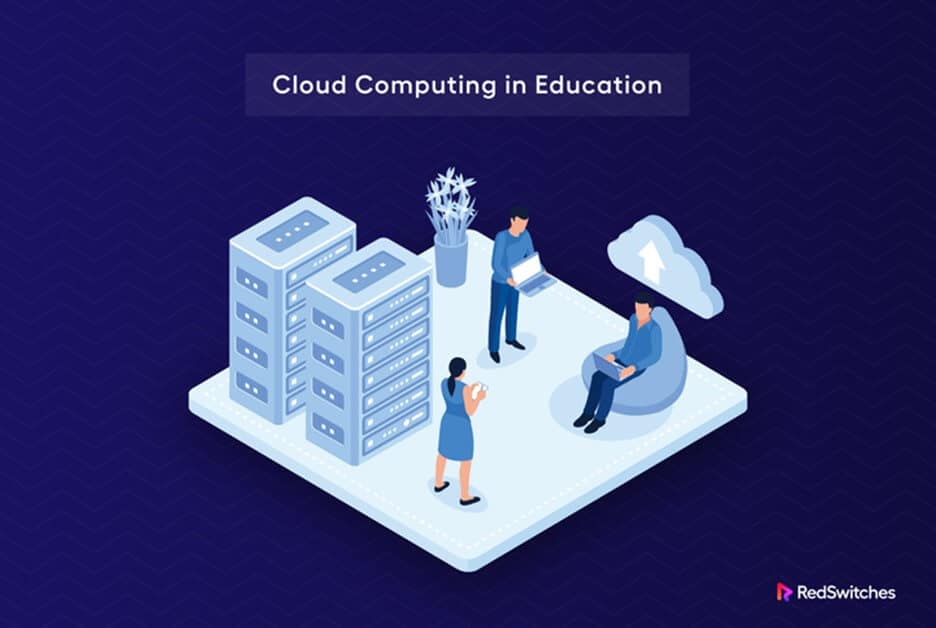Since the world embraced cloud computing, many industries have continued to plug into the trend. The covid-19 pandemic also increased the need to migrate to the cloud, as many schools had to continue learning remotely. The advantages of cloud computing in education are so much that over 50% of educational systems utilize it. Chances are high that your institution currently uses cloud computing resources.
Cloud computing is delivering a set of computing resources via the internet. Cloud computing allows anyone with access to the internet, irrespective of location, to enjoy the services and infrastructure of the cloud. Educational institutions such as schools, colleges, and universities have innumerable opportunities from cloud computing. The cloud brings instructors, students, and administrators together for a better learning experience.
A vital benefit of the cloud in academia is that it reduces the need to own or purchase physical servers and data centers. In this new cloud world, your resources are kept safe and secure on the cloud. Not only that, students and instructors can continue learning as long as there is access to an internet connection. What is the impact of cloud computing on education? Read on to find out.
Table of Content
What Are The 7 Benefits Of Cloud Computing For Education?
There are several advantages and disadvantages of cloud computing in education. Here are the top 7 benefits cloud computing offers in academics.
Cost Savings
When educational institutions move to the cloud, they save the cost of owning and managing computing infrastructure. They also save the cost of purchasing expensive software as service providers can offer it at reasonable prices. They only need computers, tablets, or mobile devices compared to hard drives and servers. Also, when students can access learning resources online, it minimizes the need for paper. This, in turn, eliminates the cost of photocopiers, printers, and physical storage space. Best of all, it reduces the need to purchase several huge and expensive hardcopy textbooks.
Data Security
Credit: iStock Photo
Like in any other industry, cloud computing also offers security for data and information in educational systems. Moving to the cloud suggests all students’ and instructors’ knowledge is in the cloud. In the cloud, service providers have strong measures to protect content that belongs to your institution. This security could come from strict authentication procedures before accessing or using a VPN. Virtual Private Network protects data movement to and from the cloud. These cloud data security features ensure that only the right users can access the learning materials.
Enhanced Learning Facilities
Cloud computing in education enhances learning possibilities via a virtual environment. While the teacher teaches using online courses, you, as a student, can participate in classes at your convenience. Remote learning facilities effective communication between teachers and students.
There are several cloud tools that you can use to monitor students’ progress for organization and administration. Other means for interactive quizzes, demonstrative tutorials, and discussion forums are available in the cloud. Exposure to these learning facilities removes learning from the traditional curricula and exposes institutions to updated knowledge worldwide.
Improved Collaboration
Educational institutions can improve collaboration by exploring cloud resources. The primary collaboration benefit is between the student and teacher. While the teacher monitors student participation, students can catch up with learning and submit assignments online.
Collaboration could also be among teachers. They can share plans, student data, and ideas on improvement regularly through a resource like Skype. Lastly, researchers from several parts of the world can discuss and proffer solutions to world problems via the Internet. For example, an expert in health in India can share his research findings with an analyst in the US for further studies.
Improved Disaster Recovery
Cloud computing keeps your data safe in case of emergencies and unforeseen circumstances. When you employ the services of a reputable hosting company, the cloud automatically saves changes you make to your files. For example, you can save your progress with a course and resume from where you stopped the last time.
Also, the hosting service will provide options for backup for seamless disaster recovery. You can back up files either manually or automatically. If you lose your data for any unforeseen reason, you can always get it back from the backup.
Greater Scalability
Educational systems are included as regards server scaling. Institutions will have a growing number of students, teachers, administrators, and resources to engage. This increase brings about the need for more computing facilities. Imagine an institution that doesn’t use the cloud. They will purchase more hardware, storage devices, and even physical space. However, with cloud computing, you have enough space to accommodate growing needs and users.
Improved IT Infrastructure
Credit: iStock Photo
The physical IT infrastructure for educational operations includes large data centers with multiple physical servers, hardware, and storage devices. You can see these expensive physical components, not to talk of management and upgrade. Asides from that, they place users at health risk from radiation emissions. Cloud computing gives you the advantage of improved IT such that you do not need all the hardware components in your institution.
There are several computing options you could go for, including the public, private and hybrid cloud. Any of these choices is suitable if it is within your budget and educational needs. Managing cloud IT infrastructure is also improved, as you can organize activities on the cloud from a single management platform.
Key Takeaways
Here you have the benefits of cloud computing in education. The knowledge of the impact of cloud computing in education gives you an improved and secure learning experience in your institution. So, of all the information in this article, pay attention to these critical points.
- Cloud computing can help educational institutions streamline operations, reduce costs, and provide better student learning experiences.
- By leveraging cloud hosting services, educational institutions can use the latest technology trends and best practices to stay competitive in today’s fast-paced digital landscape.
- Cloud hosting services offer a range of benefits, including data security, cost-effectiveness, scalability, enhanced collaboration, and access to a wide range of educational tools and resources.
- As a cloud hosting service provider, our company is uniquely positioned to help educational institutions optimize their operations and take advantage of the benefits of cloud computing in education.
Now that you know all about the advantages of cloud computing in education, you will need a reliable and innovative partner to help you navigate the complex world of education. You don’t need to look any further than our company. With our expert guidance and cutting-edge cloud hosting services, we can help you unlock the full potential of cloud computing in education and achieve your educational goals.
Frequently Asked Questions (FAQs)
1. What is the impact of cloud computing in education?
Students who reside in rural locations or other areas where modern educational materials are not readily available can benefit immensely from using cloud computing in the classroom.
A cloud-based learning system can assist kids in remote areas receive the education they require to compete in the contemporary world.
Although it may be very optimistic to believe that infrastructure can reach those locations, the effort would be well worth it.
Working professionals who do not have time to attend regular classes would also profit from a modernized education system because they can access online learning possibilities whenever it is most convenient for them.
2. What is the use of cloud computing in higher education?
Cloud computing allows for immediate connection and collaboration in the classroom. Data is stored in the cloud rather than on individual devices, allowing students, educators, and staff to collaborate independent of physical location.
3. Is cloud computing secure for storing student and staff data?
Cloud computing can be safe for keeping student and faculty data, but it depends on several criteria. Here are some things to think about when it comes to the security of cloud computing for data storage at educational institutions:
Data Encryption, Access Controls and Authentication, Data Privacy and Compliance, Data Backup, Disaster Recovery, Security Audits, Certifications, Data Ownership, Contractual Agreements, and so on.
4. Can cloud computing help reduce IT infrastructure costs for educational institutions?
Yes, absolutely cloud computing can help reduce IT infrastructure costs for educational institutions. Here’s how:
- Reduced Hardware Costs.
- Pay-as-You-Go Model.
- Lower Maintenance Costs.
- Energy Efficiency.
- Centralized Management.
- Enhanced Disaster Recovery.
5. Are there any disadvantages of cloud computing in education?
Given its multiple benefits, such as accessibility, scalability, and cost-effectiveness, cloud computing has grown in popularity in the education industry. It does, however, have some downsides that should be considered. Here are a few of the significant drawbacks of cloud computing in education:
- Dependence on Internet Connectivity.
- Concerns about data security.
- Reliance on Service Providers
- Cost implication.
Availability and Reliability of Internet Infrastructure.



